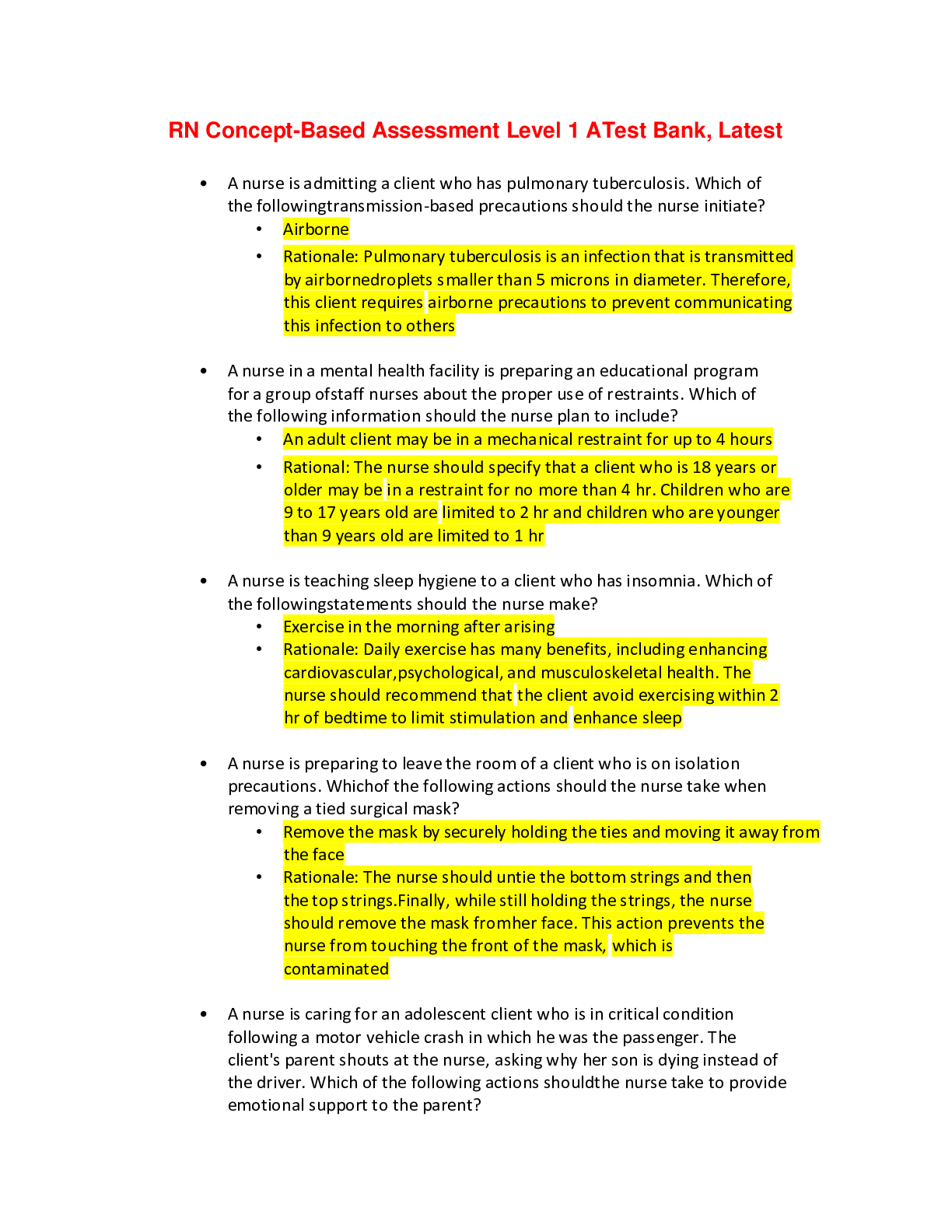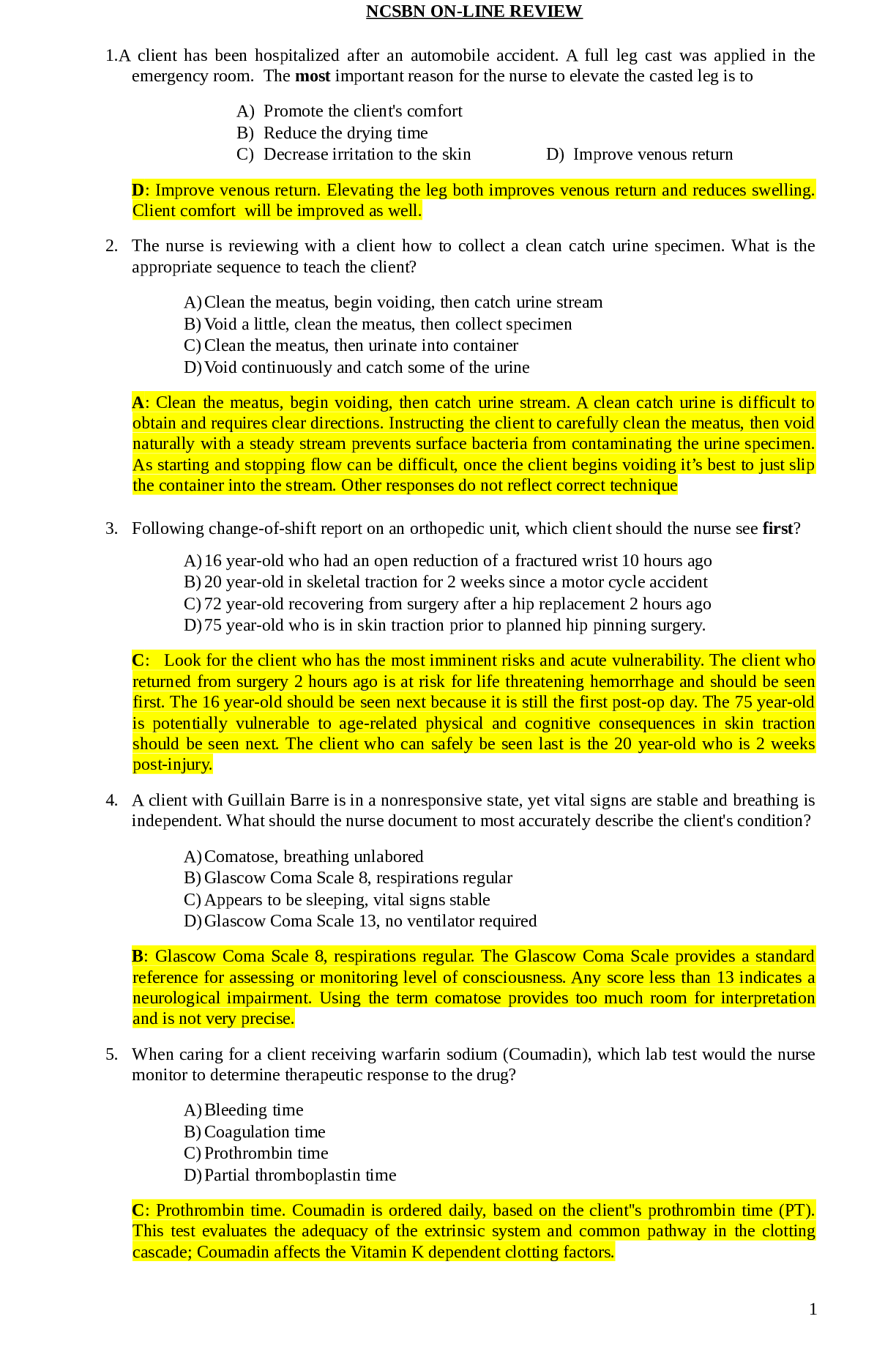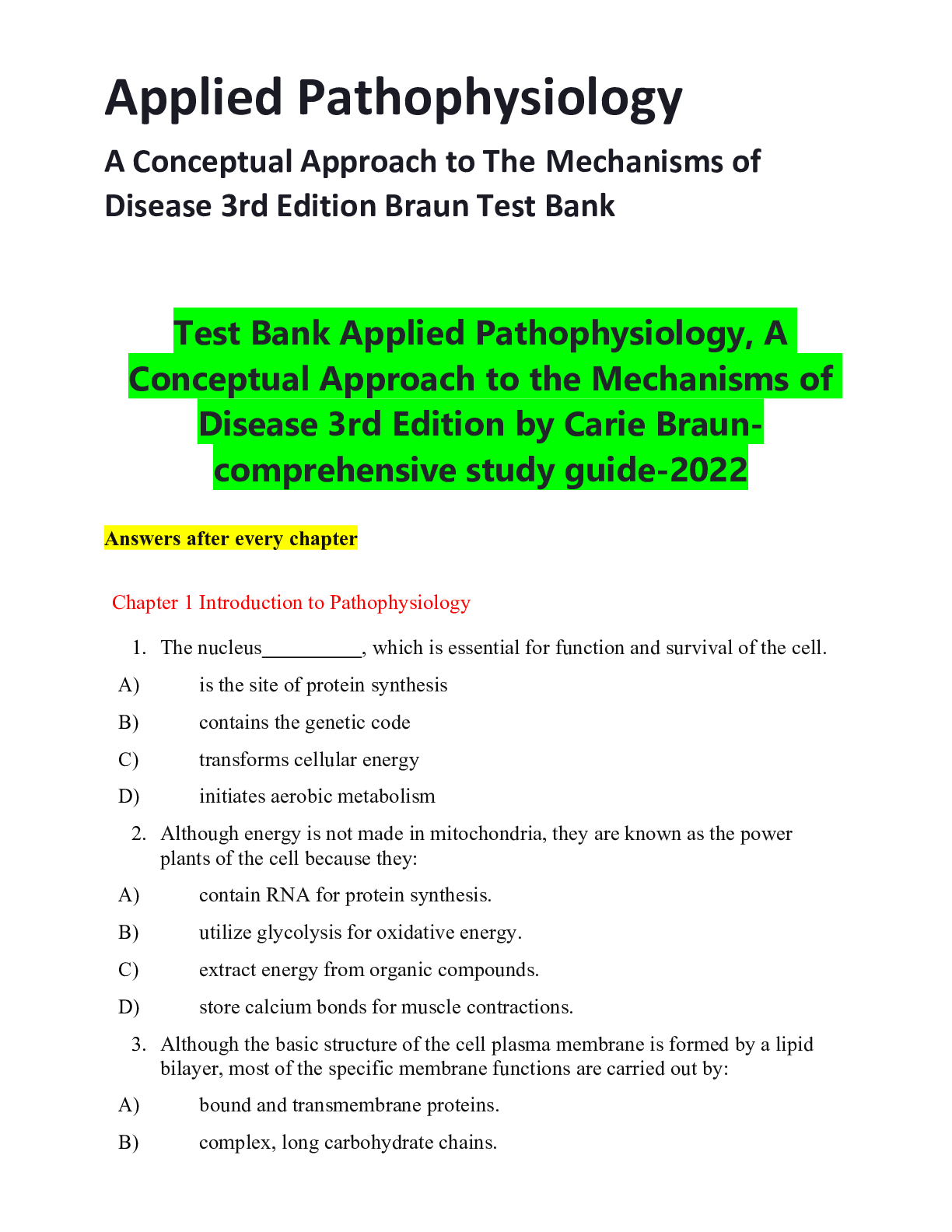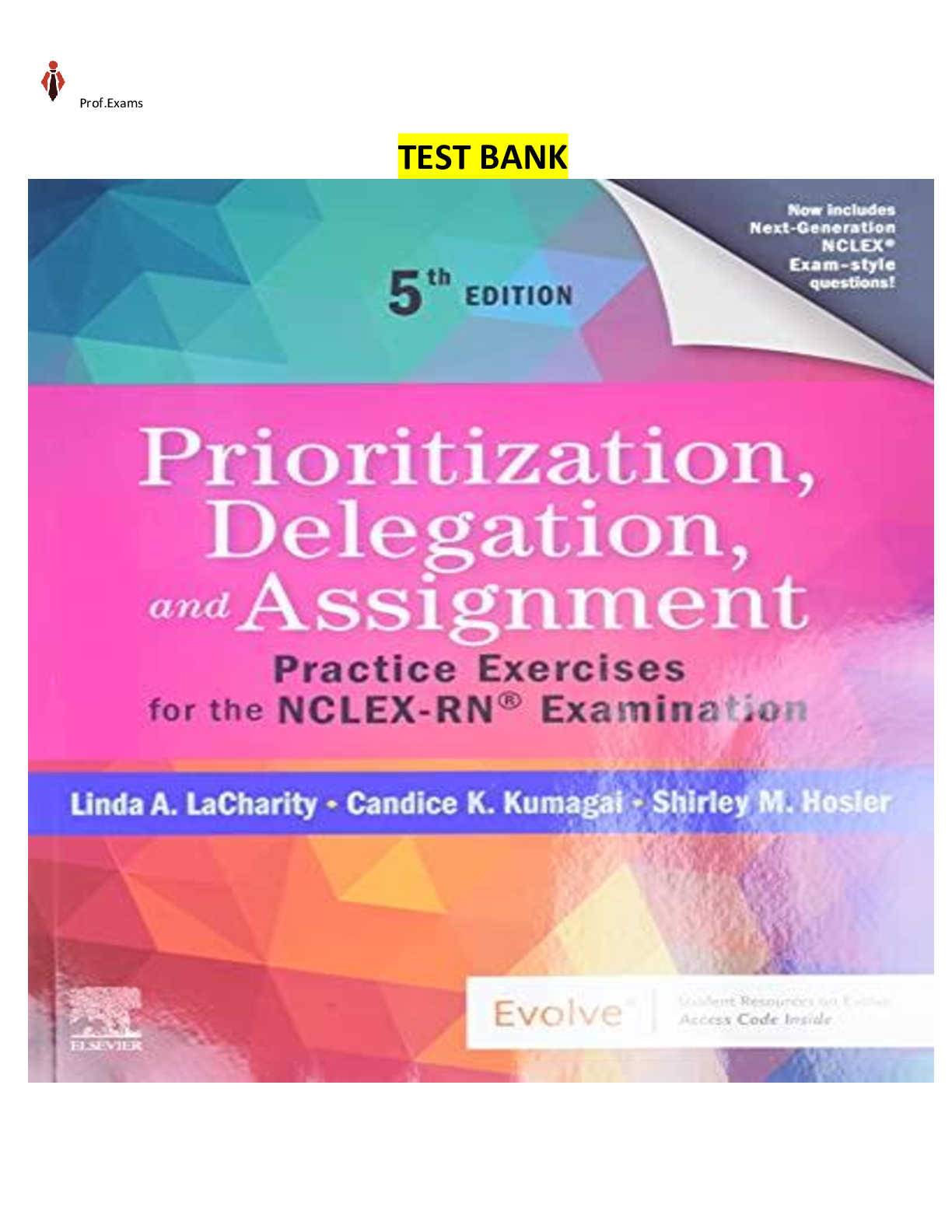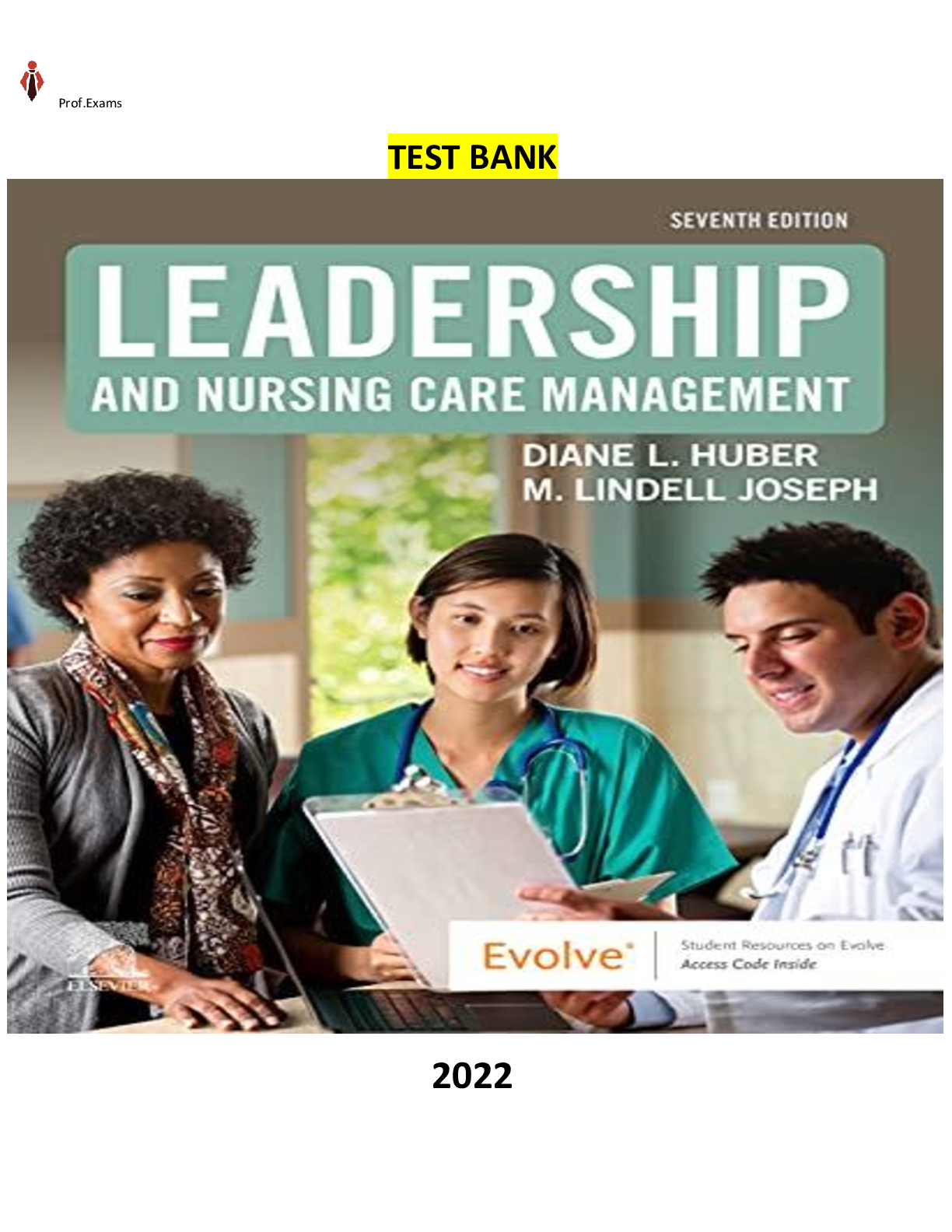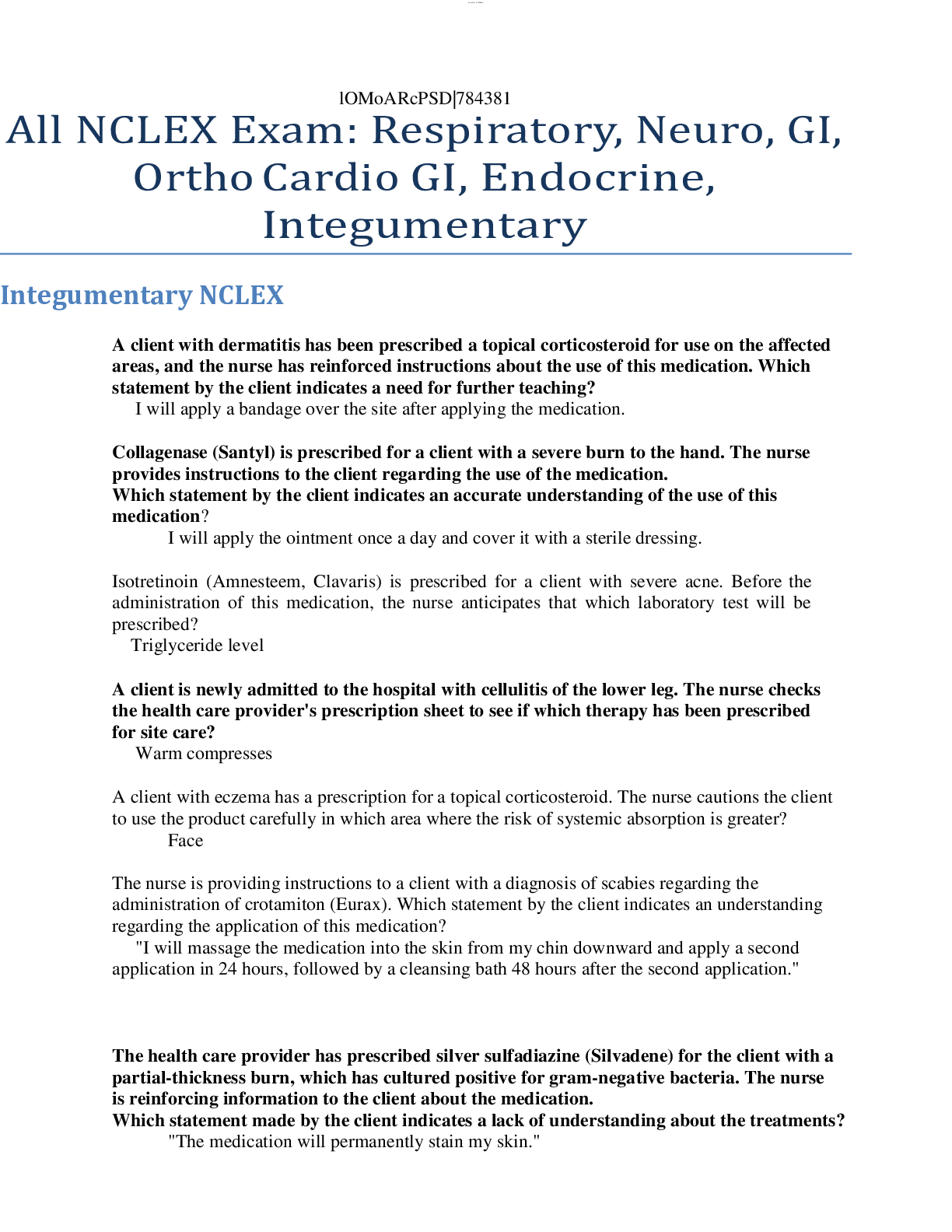*NURSING > TEST BANK > Chapter 9: NURS 340 Preparation For The Nclex Questions and Answers Test Bank,100% CORRECT (All)
Chapter 9: NURS 340 Preparation For The Nclex Questions and Answers Test Bank,100% CORRECT
Document Content and Description Below
Chapter 9: NURS 340 Preparation For The Nclex Questions and Answers Test Bank Origin: Chapter 9, 1 1. The nurse is caring for children in a physician's office where health supervision is practiced.... Which are some points of focus of health supervision? Select all that apply. A) Making referrals for all health care needs B) Monitoring disease incidence C) Optimizing the child's level of functioning D) Monitoring quality of care provided E) Teaching parents to prevent injury F) Providing care developed from national guidelines Ans: C, E, F Feedback: Health supervision involves providing services proactively, with the goal of optimizing the child's level of functioning. It ensures the child is growing and developing appropriately and it promotes the best possible health of the child by teaching parents and children about preventing injury and illness (e.g., proper immunizations and anticipatory guidance). The framework for the health supervision visit is developed from national guidelines available through the U.S. Department of Health and Human Services (DHHS), the American Medical Association (AMA), and the American Academy of Pediatrics (AAP). Making referrals and monitoring disease incidence and quality of care provided may occur with this model, but they are not key focal points. Origin: Chapter 9, 2 2. The nurse is providing care for children in a pediatric medical home. What is a characteristic of care in these types of facilities? A) All insurance except Medicaid is accepted. B) Ambulatory care is not provided C) A centralized database contains all child information. D) Continuity of care is provided from infancy through adulthood. Ans: C Feedback: In a medical home a centralized database contains all pertinent information. All insurance including Medicaid is accepted in the medical home and ambulatory care is provided. Continuity of care is also provided from infancy to adolescence. Origin: Chapter 9, 3 3. The nurse is preparing a presentation to a local parent group about pediatric health supervision. Which would the nurse emphasize as the focus? A) Injury prevention B) Wellness C) Health maintenance D) Developmental surveillance Ans: B Feedback: The focus of pediatric health supervision is wellness. Injury and disease prevention, health maintenance and promotion, and developmental surveillance are all critical components of wellness. Origin: Chapter 9, 4 4.A large portion of the nurse's efforts is dedicated to health supervision for children who use the facility as their primary medical contact. At which facility does the nurse work? A) An urgent care center B) A pediatric practice C) A mobile outreach immunization program D) A dermatology practice Ans: B Feedback: A pediatric practice is most likely to fulfill the characteristics for primary care, also known as a medical home. An urgent care center does not provide preventative care activities. Mobile outreach would not provide for any care requiring hospitalization. A dermatology practice is unlikely to provide service outside its area of specialization. Origin: Chapter 9, 5 5. The nurse strives to provide culturally competent care for children in a health clinic that follows the principles of health supervision. Which nursing action reflects this type of care? A) The nurse treats all children the same regardless of their culture. B) The nurse negotiates a care plan with the child and family. C) The nurse researches the child's culture and provides care based on the findings. D) The nurse provides future-based care for culturally diverse children. Ans: B Feedback: Optimal wellness for the child requires the nurse and the family to negotiate a mutually acceptable plan of care. The nurse must consider the culture of children because if the goals of the health care plan are not consistent with the health belief system of the family, the plan has little chance for success. Researching the culture is helpful, but the nurse should not assume all children follow cultural directives and base the care plan solely on the research. Most health promotion and disease prevention strategies in the United States have a future-based orientation; however, significant numbers of children belong to cultures with a present-based orientation. For these children, health promotion activities need shorter-term goals and outcomes to be useful. Origin: Chapter 9, 6 6. The nurse is aware that the community affects the health of its members. Which statements accurately reflect a community influence of health care? Select all that apply. A) A community can be a contributor to a child's health or be the cause of his or her illnesses. B) The child's health should be separated from the health of the surrounding community. C) Community support and resources are necessary for children with significant problems. D) Poverty has not been linked to an increase in health problems in communities. E) The breakdown of community and family support systems can lead to depression and violence. F) Ideally, the child's medical home is located outside the community. Ans: A, C, E Feedback: A community can be a contributor to a child's health or be the cause of his or her illnesses. Community support and resources are necessary for children with significant problems since a close working relationship between the child's physician and community agencies is an enormous benefit to the child. Children from communities suffering the large-scale breakdown of family relationships and loss of support systems will be at increased risk for depression, violence and abuse, substance abuse, and HIV infection. The child's health cannot be totally separated from the health of the surrounding community. Poverty has been linked to low birthweight and premature birth, among other health problems. Ideally the child's medical home is within the family's community to reduce barriers such as lack of transportation, expense of travel, and time away from the parents' workplace. Origin: Chapter 9, 7 7. The nurse is conducting a psychosocial assessment of a child with asthma brought to the physician's office for a check-up. Which psychosocial issues may be assessed? Select all that apply. A) Health insurance coverage B) Transportation to health care facilities C) School's response to the chronic illness D) Past medical history E) Future treatment plans F) Health maintenance needs Ans: A, B, C Feedback: Comprehensive health supervision includes frequent psychosocial assessments. Issues to be covered include health insurance coverage, transportation to health care facilities, financial stressors, family coping, and the school's response to the chronic illness. These are often stressful and emotionally charged issues. Past medical history, future treatment plans, and health maintenance needs would also be assessed; however, these are not psychosocial issues. Origin: Chapter 9, 8 8. The nurse is examining a 2-year-old child who was adopted from Guatemala. What would be a priority screening for this child? A) Screening for congenital defects B) Screening for abuse C) Screening for childhood illnesses D) Screening for infectious diseases Ans: D Feedback: Although all the screenings are important, health supervision of the internationally adopted child must include comprehensive screening for infectious disease. In 2008, approximately 19,600 children were adopted from countries outside the United States, many from areas with a high prevalence of infectious diseases (Intercountry Adoption, Office of Children's Issues, U.S. Department of State, 2010a, 2010b). Guatemala, China, and Russia supplied about half of all international adoptees in 2008, followed by Ethiopia, South Korea, and Vietnam. Proper screening is important not only to the child's health but also to the adopting family and the larger community. Origin: Chapter 9, 9 9. The mother of a 5-year-old child with eczema is getting a check-up for her child before school starts. What will the nurse do during the visit? A) Change the bandage on a cut on the child's hand B) Assess the compliance with treatment regimens C) Discuss systemic corticosteroid therapy D) Assess the child's fluid volume Ans: B Feedback: Maintaining proper therapy for eczema can be exhausting both physically and mentally. Therefore, it is essential that the nurse assess compliance and support the parents' ability to cope if necessary. Changing a bandage is not part of a health maintenance visit. Hydration is important for a child with eczema; however, fluid volume is not the focus at this visit. Systemic corticosteroid therapy is very rarely used and the success of the current therapy needs to be assessed first. Origin: Chapter 9, 10 10. During the health history, the mother of a 4-month-old child tells the nurse she is concerned that her baby is not doing what he should be at this age. What is the nurse's best response? A) "I'll be able to tell you more after I do his physical." B) "Fill out the questionnaire and then I can let you know." C) "Tell me what concerns you." D) "All mothers worry about their babies. I'm sure he's doing well." Ans: C Feedback: Asking about the mother's concerns is assessment and is the first thing the nurse should do. The mother has intimate knowledge of the infant and can provide invaluable information that can help structure the nurse's assessment. Relying on the physical assessment ignores the value of the mother's input. A screening questionnaire is no substitute for a developmental assessment. Minimizing the mother's concerns reduces communication between the mother and the nurse. Origin: Chapter 9, 11 11.A 3-year-old child is scheduled for a hearing screening. The nurse would prepare the child for screening by which method? A) Auditory brain stem response B) Evoked otoacoustic emissions C) Visual reinforcement audiometry D) Conditioned play audiometry Ans: D Feedback: For children between the ages of 2 and 4 years, conditioned play audiometry would be an appropriate method for hearing screening. Auditory brain stem response and evoked otoacoustic emissions are appropriate hearing screening methods for newborns through age 6 months. Visual reinforcement audiometry is appropriate for children ages 6 months to 2 years. Origin: Chapter 9, 12 12.A 2-week-old child responds to a bell during an initial health supervision examination. The child's records do not show that a newborn hearing screening was done. Which is the best action for the nurse to take? A) Do nothing because responding to the bell proves he does not have a hearing deficit. B) Immediately schedule the infant for a newborn hearing screening. C) Ask the mother to observe for signs that the infant is not hearing well. D) Screen again with the bell at the 2-month-old health supervision visit. Ans: B Feedback: Guidelines for infant hearing screening recommend universal screening with an auditory brain stem response (ABR) or evoked otoacoustic emissions (EOAE) test by 1 month of age. All the other answers rely on behavioral observation. Studies have shown that behavioral observations are not a reliable method of screening for hearing loss. Origin: Chapter 9, 13 13. The nurse is performing developmental surveillance for children at a medical home. Which infants are most at risk for developmental delays? Select all that apply. A) A child whose birthweight was 1,600 g B) A child whose parent has a mental illness C) A child raised by a single parent D) A child with a lead level above 10 mg/dL E) A child with hypertonia or hypotonia F) A child with gestational age more than 33 weeks Ans: B, C, D, E Feedback: Risk factors for developmental delays include having a single parent, a parent with developmental disability or mental illness, hypertonia or hypotonia, birthweight less than 1,500 g, lead level above 5 mg/dL, and gestational age less than 33 weeks. Origin: Chapter 9, 14 14. The nurse is examining a 15-month-old child who was able to walk at the last visit and now can no longer walk. What would be the nurse's best intervention in this case? A) Schedule a full evaluation since this may indicate a neurologic disorder. B) Note the regression in the child's chart and recheck in another month. C) Document the findings as a developmental delay since this is a normal occurrence. D) Ask the parents if they have changed the child's schedule to a less active one. Ans: A Feedback: Any child who "loses" a developmental milestone—for example, the child able to sit without support who now cannot—needs an immediate full evaluation, since this indicates a significant neurologic problem. Origin: Chapter 9, 15 15. During a physical assessment of a 5-month-old child, the nurse observes the first tooth has just erupted and uses the opportunity to advise the mother to schedule a dental examination for her baby. When is the correct time for the dentist visit? A) By the first birthday B) By the second birthday C) By entry into kindergarten D) By entry into first grade Ans: A Feedback: The American Academy of Pediatric Dentistry recommends that a dentist examine the infant by his or her first birthday. Besides assessing routine oral health care, establishing a dental contact by the first birthday provides a resource for emergency dental care if it is needed. Origin: Chapter 9, 16 16.A mother and her 4-week-old infant have arrived for a health maintenance visit. Which activity will the nurse perform? A) Assess the child for an upper respiratory infection B) Take a health history for a minor injury C) Administer a varicella injection D) Plot the child's head circumference on a growth chart Ans: D Feedback: The nurse will plot the head circumference of the child as part of developmental surveillance and screening. Assessing for an infection and taking a health history for an injury are not part of a health maintenance visit. Administering a vaccination for varicella would not occur until 12 months of age. Origin: Chapter 9, 17 17. The nurse is screening a 6-year-old child for mental ability. Which test would the nurse use to assess intelligence? A) Denver Articulation Screening B) Denver PRQ C) Goodenough-Harris Drawing Test D) Parents' Evaluation of Developmental Status (PEDS) Ans: C Feedback: The Goodenough-Harris Drawing Test is a nonverbal screen for mental ability (intelligence). The Denver Articulation Screening screens for articulation disorders. The Denver PRQ assesses personal–social, fine motor–adaptive, language, and gross motor skills. The PEDS screens for a wide range of developmental, behavioral, and family issues. Origin: Chapter 9, 18 18. When assessing the vision of a 2-month-old, what would the nurse use? A) Black-and-white checkerboard B) Red and blue circles C) Gray and blue animal drawings D) Green and yellow letters Ans: A Feedback: For infants younger than 6 months of age, objects such as a black-and-white checkerboard or concentric circles are best because an infant's vision is more attuned to these high-contrast patterns than to colors. High-contrast animal figures such as pandas or Dalmatians also work well. Origin: Chapter 9, 19 19. The nurse is performing a risk assessment of a 5-year-old and determines the child has a risk factor for cystic fibrosis. What type of screening would the nurse perform to confirm or rule out this disease? A) Universal screening B) Selective screening C) Hyperlipidemia screening D) Developmental screening Ans: B Feedback: Selective screening is done when a risk assessment indicates the child has one or more risk factors for the disorder. In universal screening, an entire population is screened regardless of the child's individual risk. Selectively screening children at high risk for hyperlipidemia can reduce their lifelong risk of coronary artery disease; it does not screen for cystic fibrosis. Developmental screening is performed to detect developmental delays. Origin: Chapter 9, 20 20. The nurse is caring for an infant who had hyperbilirubinemia requiring exchange transfusion. Based on this information, this infant is at risk for what type of disorder? A) Vision loss B) Hearing loss C) Hypertension D) Hyperlipidemia Ans: B Feedback: There are many conditions that place an infant at risk for hearing loss, including an exchange transfusion with hyperbilirubinemia. A risk factor for vision loss is history of ocular structural abnormalities. Risk factors for systemic hypertension include preterm birth, very low birthweight, renal disease, organ transplant, congenital heart disease, or other illnesses associated with hypertension. A risk factor for hyperlipidemia is family history. Origin: Chapter 9, 21 21. The nurse is performing a vision screening for a 4-year-old child. Which screening chart would be best for determining the child's visual acuity? A) Snellen B) Ishihara C) Allen figures D) Color Vision Testing Made Easy (CVTME) Ans: C Feedback: The Allen figures chart is reliable for assessing visual acuity for a preschool child. The Snellen chart requires that the child has a good knowledge of the alphabet. This is not an expectation for a 4-year-old child. The Ishihara and CVTME charts are designed to assess color vision discrimination and not visual acuity. Origin: Chapter 9, 22 22. The nurse is explaining the difference between active and passive immunity to the student nurse. Which statement accurately describes a characteristic of the process of immunity? A) Active immunity is produced when the immunoglobulins of one person are transferred to another. B) Passive immunity can be obtained by injection of exogenous immunoglobulins. C) Active immunity can be transferred from mothers to infants via colostrum or the placenta. D) Passive immunity is acquired when a person's own immune system generates the immune response. Ans: B Feedback: Passive immunity can be obtained by injection of exogenous immunoglobulins. Passive immunity is produced when the immunoglobulins of one person are transferred to another. Passive immunity can also be transferred from mothers to infants via colostrum or the placenta. Active immunity is acquired when a person's own immune system generates the immune response. Origin: Chapter 9, 23 23. The nurse is administering a hepatitis B vaccine to a child. What is the classification of this type of vaccine? A) Killed vaccines B) Toxoid vaccines C) Conjugate vaccines D) Recombinant vaccines Ans: D Feedback: Recombinant vaccines use genetically engineered organisms. The hepatitis B vaccine is produced by splicing a gene portion of the virus into a gene of a yeast cell. The yeast cell is then able to produce hepatitis B surface antigen to use for vaccine production. Killed vaccines contain whole dead organisms; they are incapable of reproducing but are capable of producing an immune response. Toxoid vaccines contain protein products produced by bacteria called toxins. The toxin is heat-treated to weaken its effect, but it retains its ability to produce an immune response. Conjugate vaccines are the result of chemically linking the bacterial cell wall polysaccharide (sugar-based) portions with proteins. Origin: Chapter 9, 24 24. The nurse is discussing vaccination for Haemophilus influenzae type B (Hib) with the mother of a 6-month-old child. Which comment provides the most compelling reason to get the vaccination? A) "These bacteria live in every human." B) "Young children are especially susceptible to these bacteria." C) "You have a choice of two excellent vaccines." D) "Your child needs this final dose for protection." Ans: B Feedback: The most compelling reason for vaccination is that the highest rate of illness from influenza is in children. The fact that Hib is an opportunistic bacterium that lives in humans and only causes disease when resistance is lowered may be difficult for the parent to understand. A choice of two vaccines conveys no benefits to the mother. Need for the final dose is vague. Origin: Chapter 9, 25 25. The mother of a 15-month-old child is questioning the nurse about the need for the hepatitis B vaccination. Which comment provides the most compelling reason for the vaccine? A) "The most common side effect is injection site soreness." B) "This is a recombinant or genetically engineered vaccine." C) "Immunizations are needed to protect the general population." D) "This protects your child from infection that can cause liver disease." Ans: D Feedback: Up to 90% of neonates infected with hepatitis B develop chronic carrier status and will be predisposed to cirrhosis and hepatic cancer. The mother is not questioning side effects, safety, or disease prevention in general. Therefore, it is best to speak to her concerns. Origin: Chapter 9, 26 26. After teaching the mother about follow-up immunizations for her daughter, who received the varicella vaccine at age 14 months, the nurse determines that the teaching was successful when the mother states that a follow-up dose should be given at which time? A) When the child is 20 to 36 months of age B) When the child is 4 to 6 years of age C) When the child is 11 to 12 years of age D) When the child is 13 to 15 years of age Ans: B Feedback: A second dose of varicella vaccine should be given when the child is 4 to 6 years of age. Hepatitis A vaccine should be given to infants at age 12 months, with a repeat dose given in 6 to 12 months. The human papillomavirus (HPV) vaccine should be given to children beginning at age 11 to 12 years, with catch-up doses to begin at 13 to 14 years of age. Origin: Chapter 9, 27 27. The nurse working in a community clinic attempts to establish a free vaccination program to refer low-income families. What is the key strategy for success when implementing a health promotion activity? A) Partnership development B) Funding for projects C) Finding an audience D) Adequate staffing Ans: A Feedback: Partnership development is the key strategy for success when implementing a health promotion activity. Identifying key stakeholders from the community allows problems to be solved and provides additional venues for disseminating information. Funding, finding an audience, and staffing a project are elements of a public health promotion activity, but developing a partnership helps empower children and families at the individual and community levels to develop resources to optimize their health. Origin: Chapter 9, 28 28. The nurse is providing anticipatory guidance to an obese teenager. Which intervention would be most likely to promote healthy weight in teenagers? A) Make the focus of the program weight centered. B) Begin directly advising children about their weight at age 6. C) Focus physical activity on competitive sports and activities. D) Obtain nutritional histories directly from the school-age child and adolescent. Ans: D Feedback: Before providing education to school-age and teenage children, it is important to obtain nutritional histories directly from them because increasingly they are eating meals away from the family table. The focus of healthy weight promotion should be health centered, not weight centered. Linking success to numbers on a scale increases the possibility of developing eating disorders, nutritional deficiencies, and body hatred. The nurse can begin directly advising children on healthy foods starting at age 3. The focus of physical activity should be on noncompetitive, fun activities. Origin: Chapter 9, 29 29.A mother of three brings her children in for their vaccinations. The mother tells the nurse that her mother recently died and her husband just lost his job due to his company downsizing. Which parenting behaviors is the nurse likely to observe? Select all that apply. A) The mother rarely looks at her infant when the nurse is assessing the child. B) The mother voices pride in the academic accomplishments of her 7-year-old child. C) The mother becomes very frustrated and tells the nurse she can't handle her toddler's temper tantrum. D) The mother asks if the nurse has suggestions on ways to potty train her toddler. E) The mother utilizes the correct size of infant car seat for her 3-month-old child. Ans: A, C Feedback: When the family is faced with excessive stressors, the nurse may be able to ascertain the stress by observing the parent–child interaction during the health supervision visit. The nurse can learn much about the family dynamic by observing the family for behavioral clues. Lack of eye contact and care of the infant is a clue to family stress, as well as effective parenting techniques for behaviors such as temper tantrums. Origin: Chapter 9, 30 30.Three children in a family, ages 7 months, 4 years, and 9 years have been tested for lead poisoning. The two younger children's tests reflect elevated lead levels and they will be undergoing treatment. The children's mother questions why her younger children were not "spared" as their older sibling was. What response by the nurse is most correct? A) "Some children are better able to metabolize toxins such as lead after exposure." B) "Your older child has a stronger liver and kidneys, which have helped her to better rid her body of the lead." C) "Younger children are often impacted because of their play behaviors place them on the floors and they often put things into their mouths." D) "It is likely your older child may have had elevated levels earlier in life but has gotten over the condition." Ans: C Feedback: Lead poisoning is a problem that affects children younger than age 6 the most due to the fact that they are crawling on the ground and putting things in their mouths, and their developing neurologic system is more sensitive to the effects of lead. The liver and kidney development is not an influence on the degree of lead found in children's blood specimens. Metabolism is not the greatest influence on the reason why only the younger children have been impacted by lead poisoning. [Show More]
Last updated: 1 year ago
Preview 1 out of 14 pages
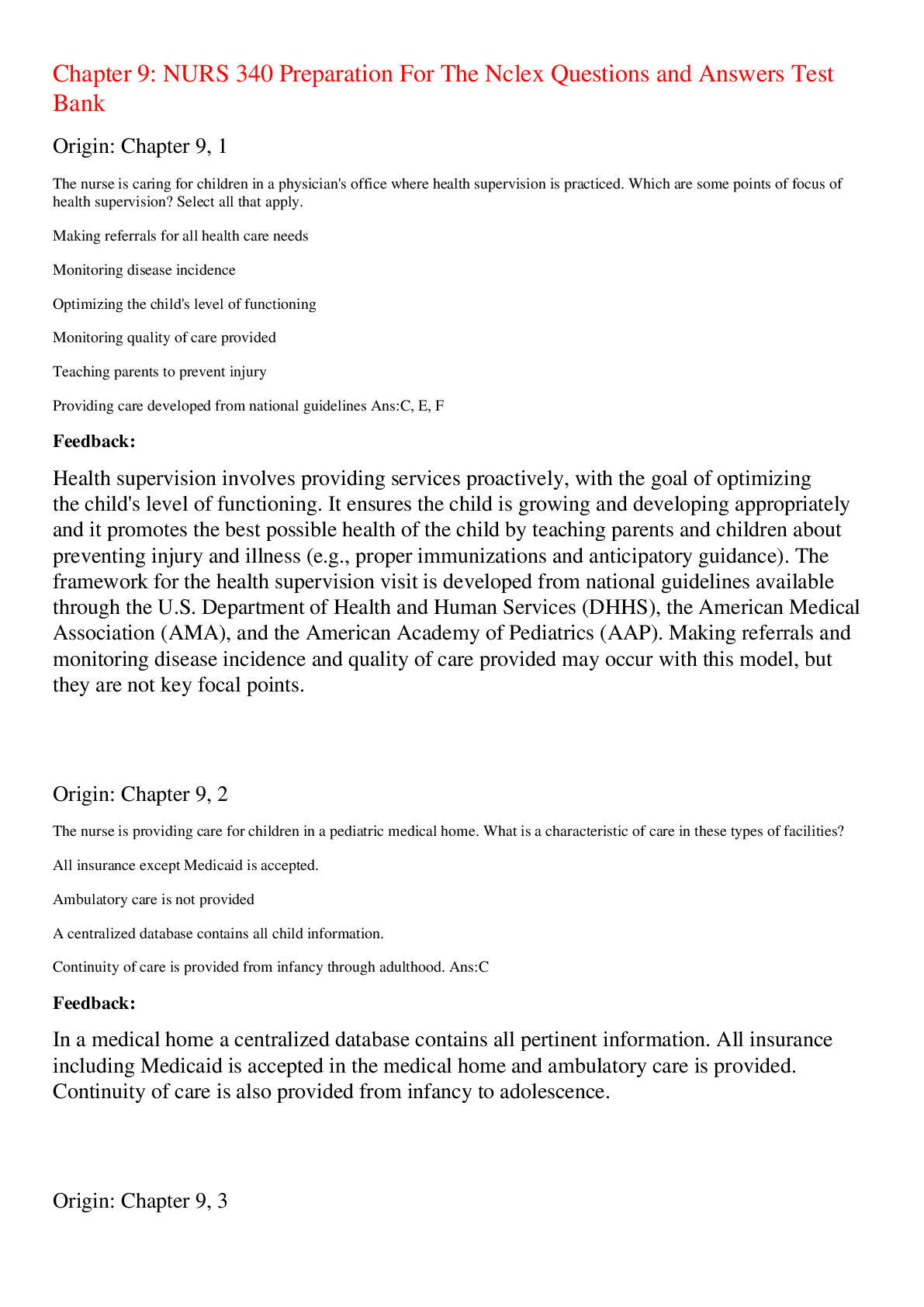
Reviews( 0 )
Document information
Connected school, study & course
About the document
Uploaded On
Feb 13, 2023
Number of pages
14
Written in
Additional information
This document has been written for:
Uploaded
Feb 13, 2023
Downloads
0
Views
37

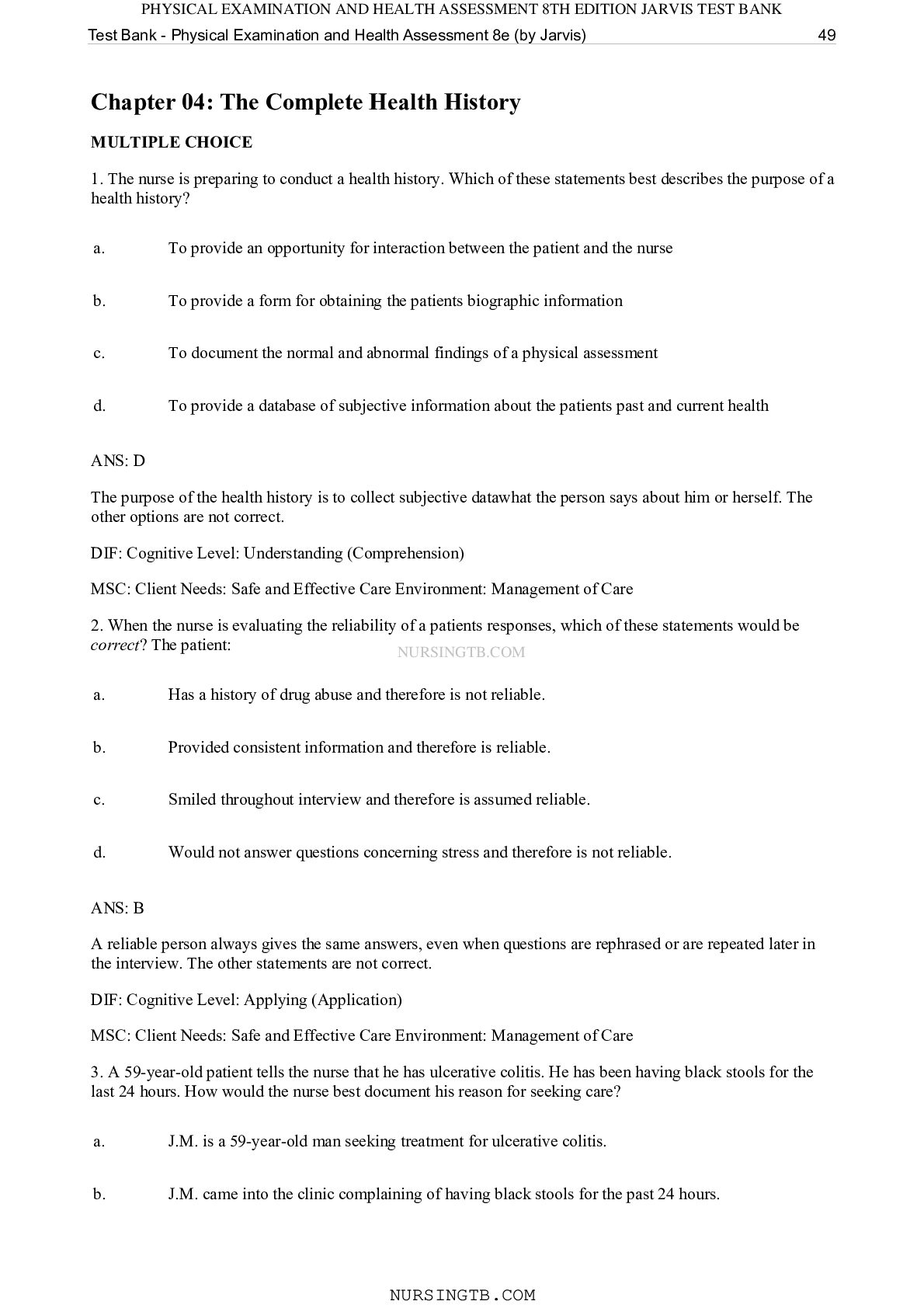









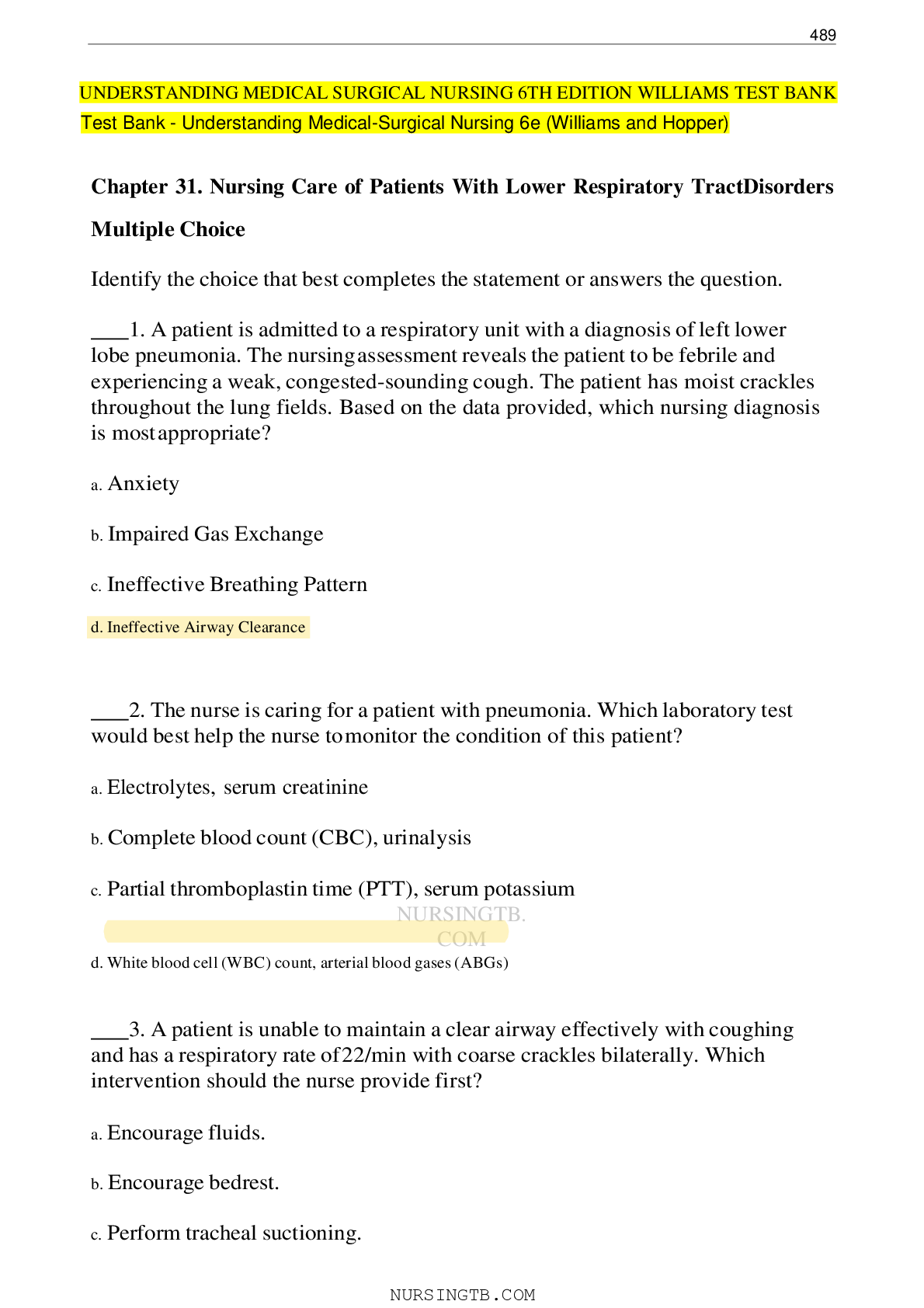

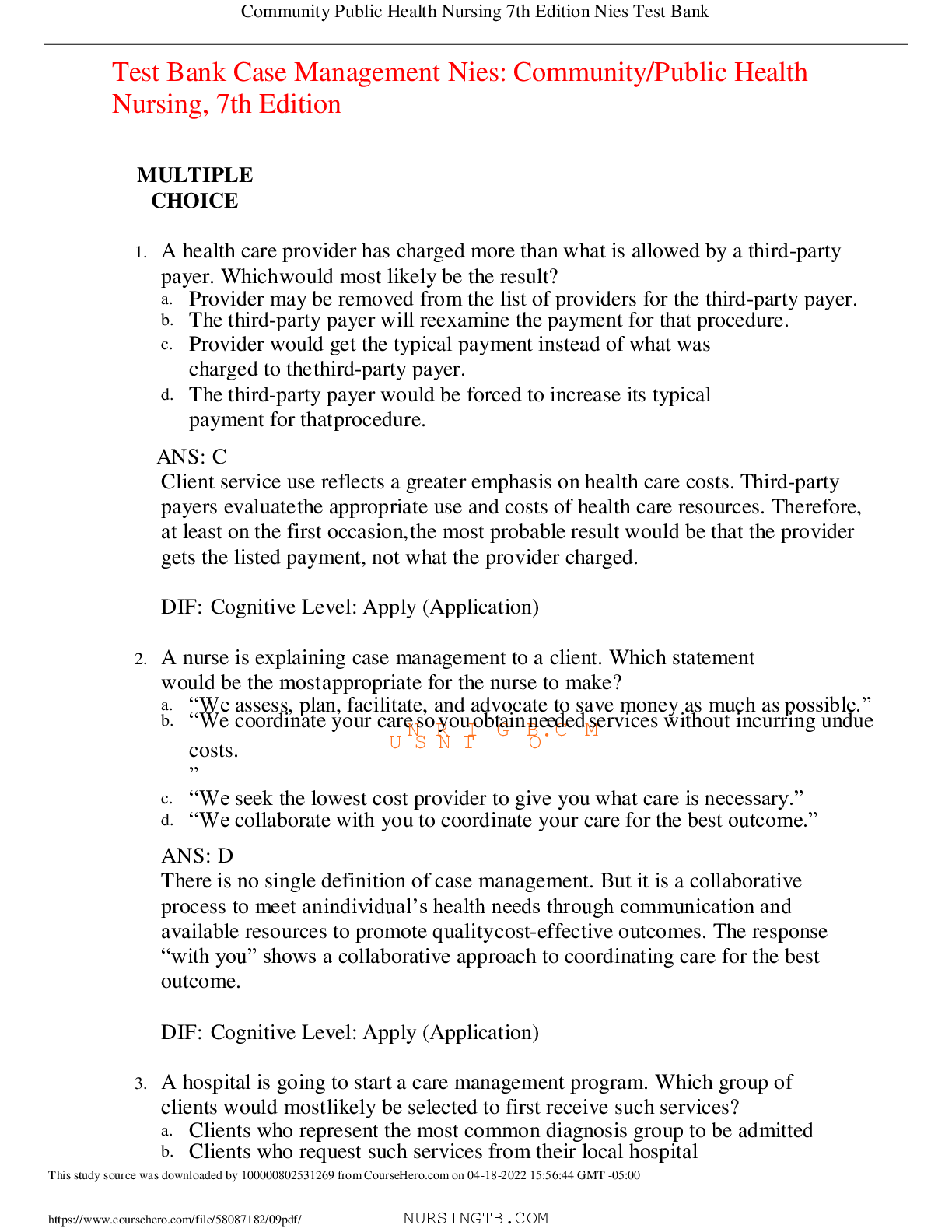

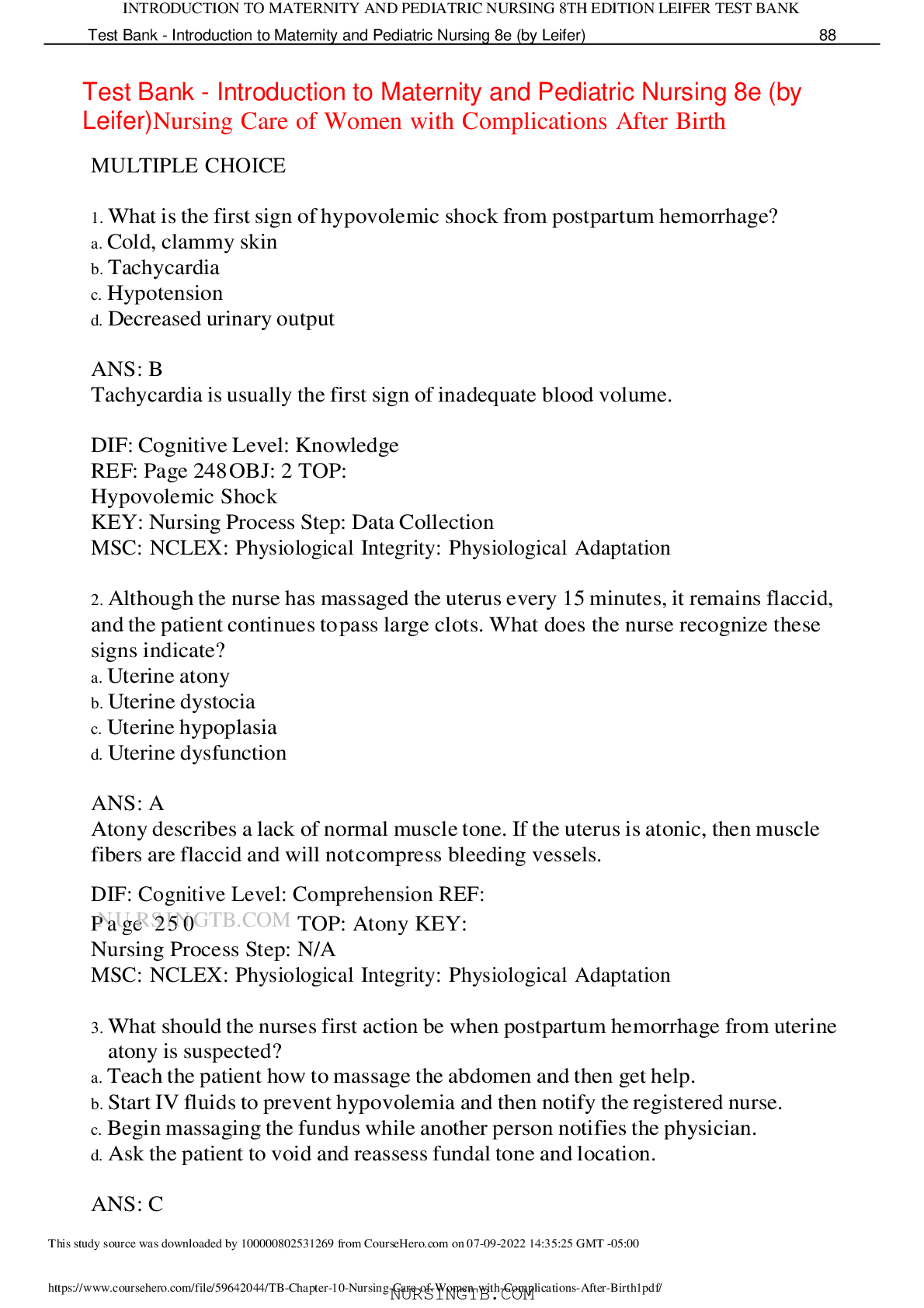

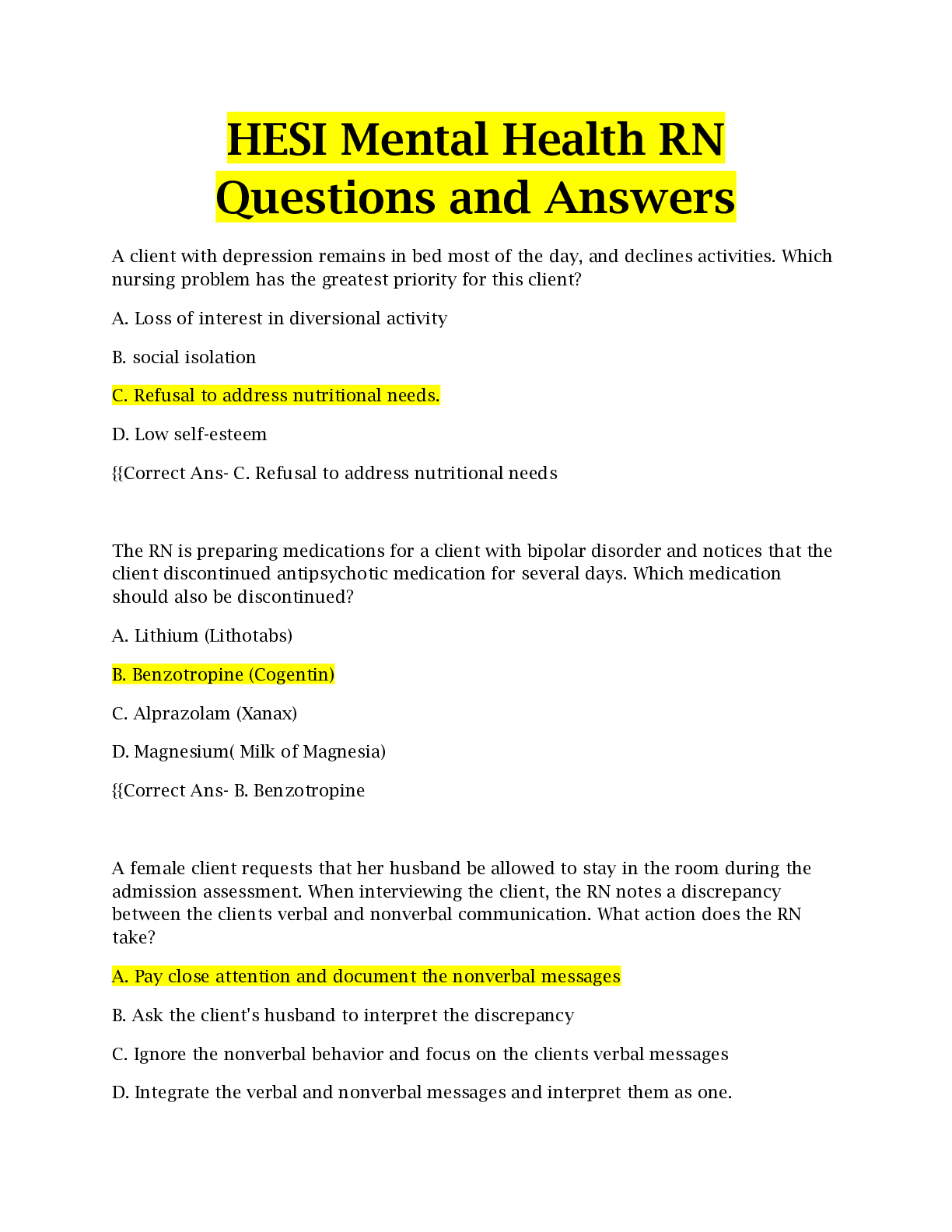
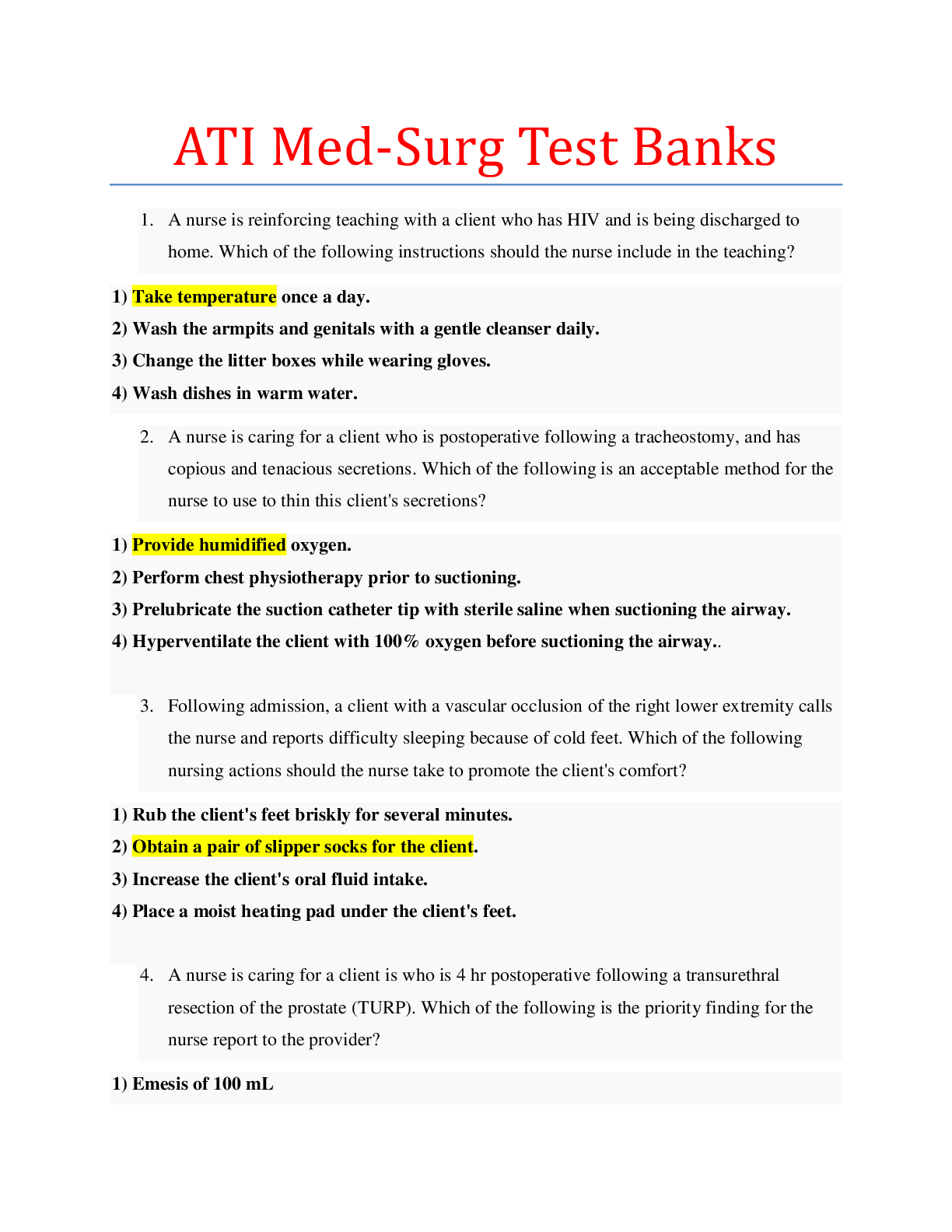


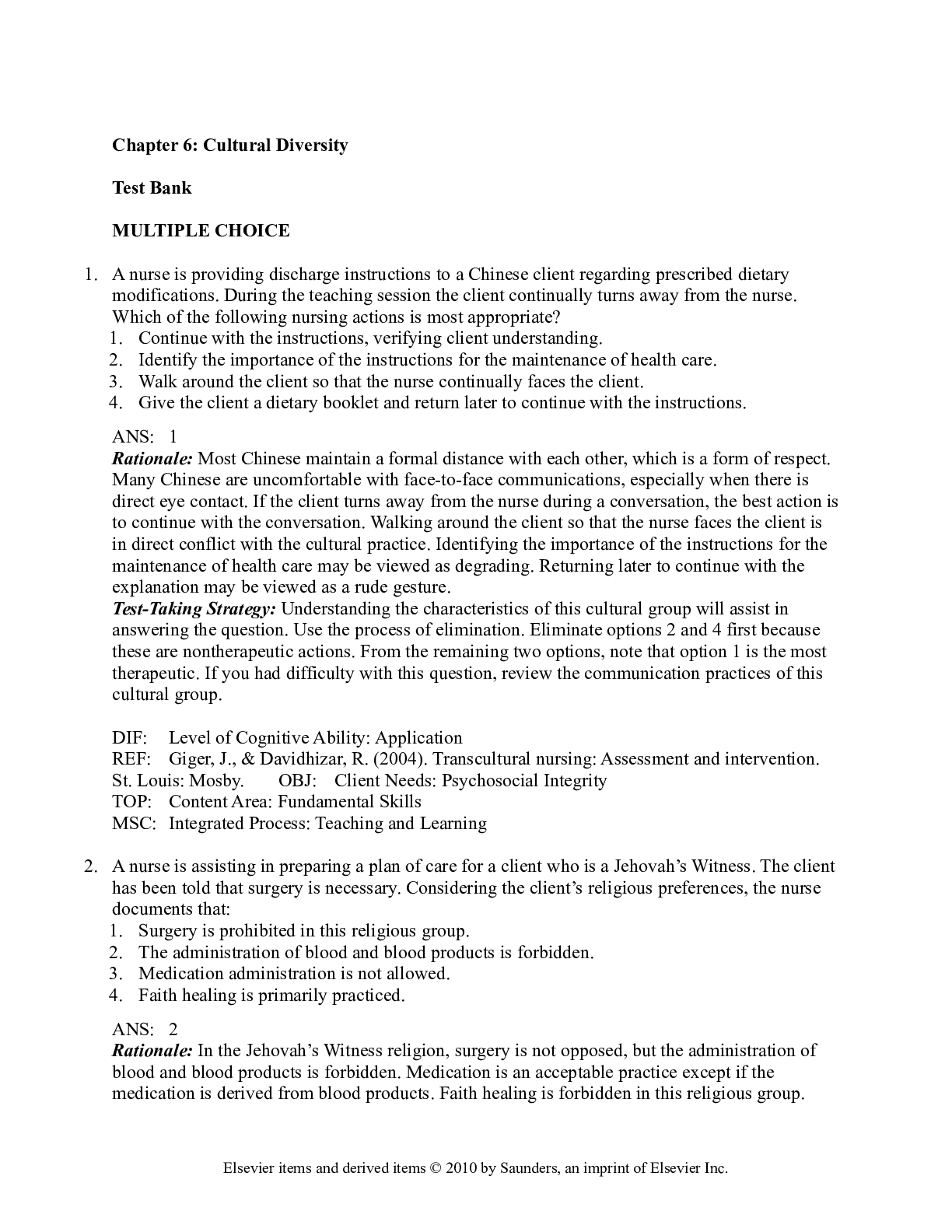
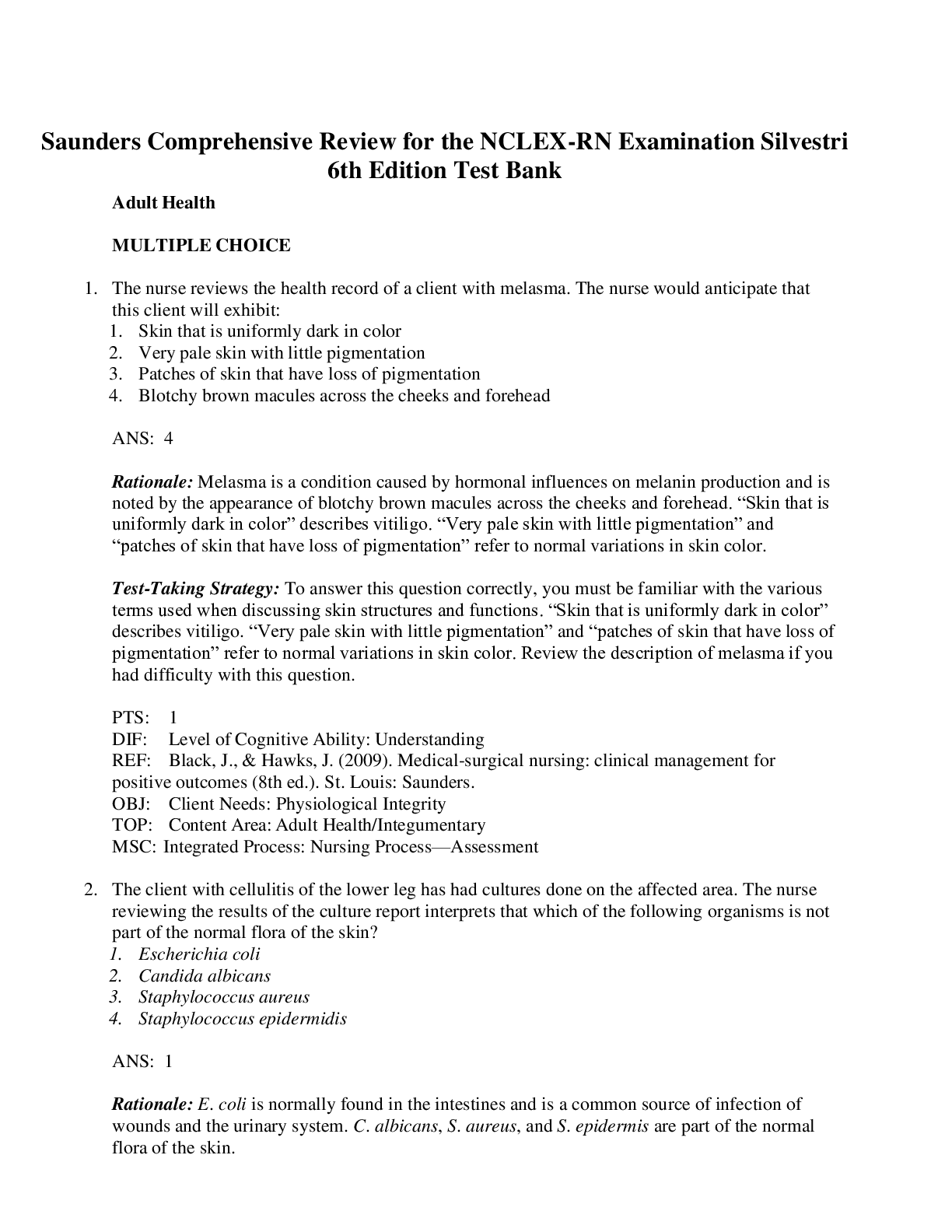
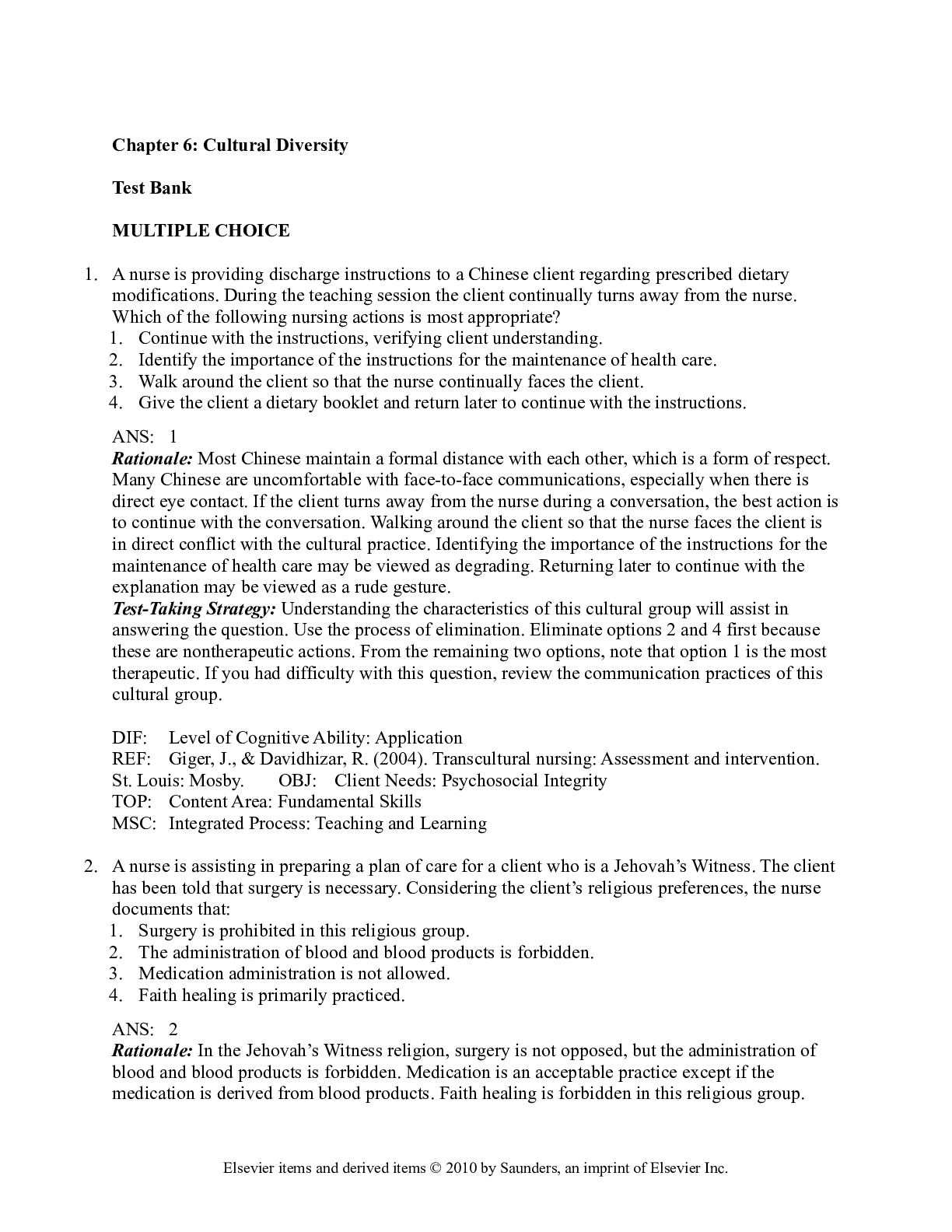

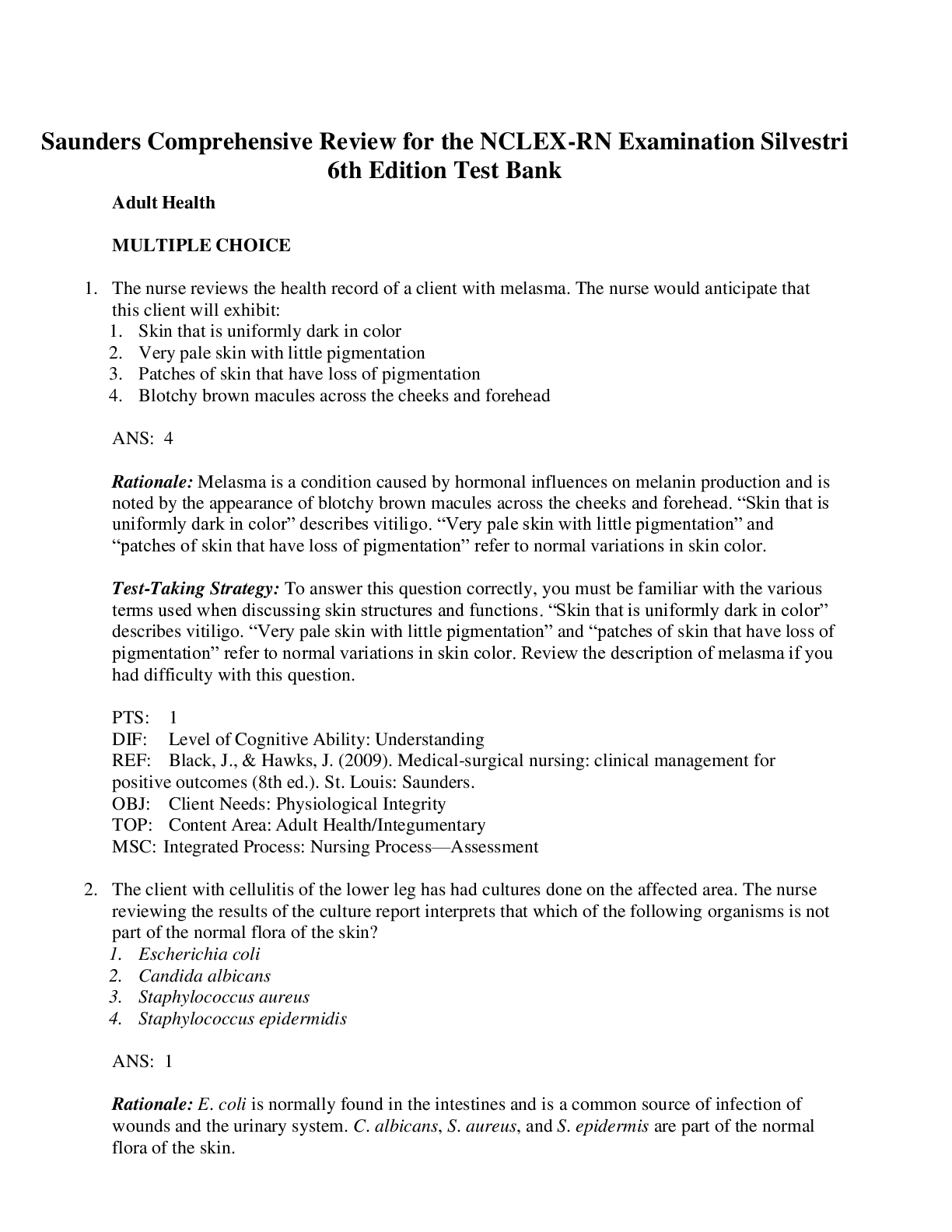
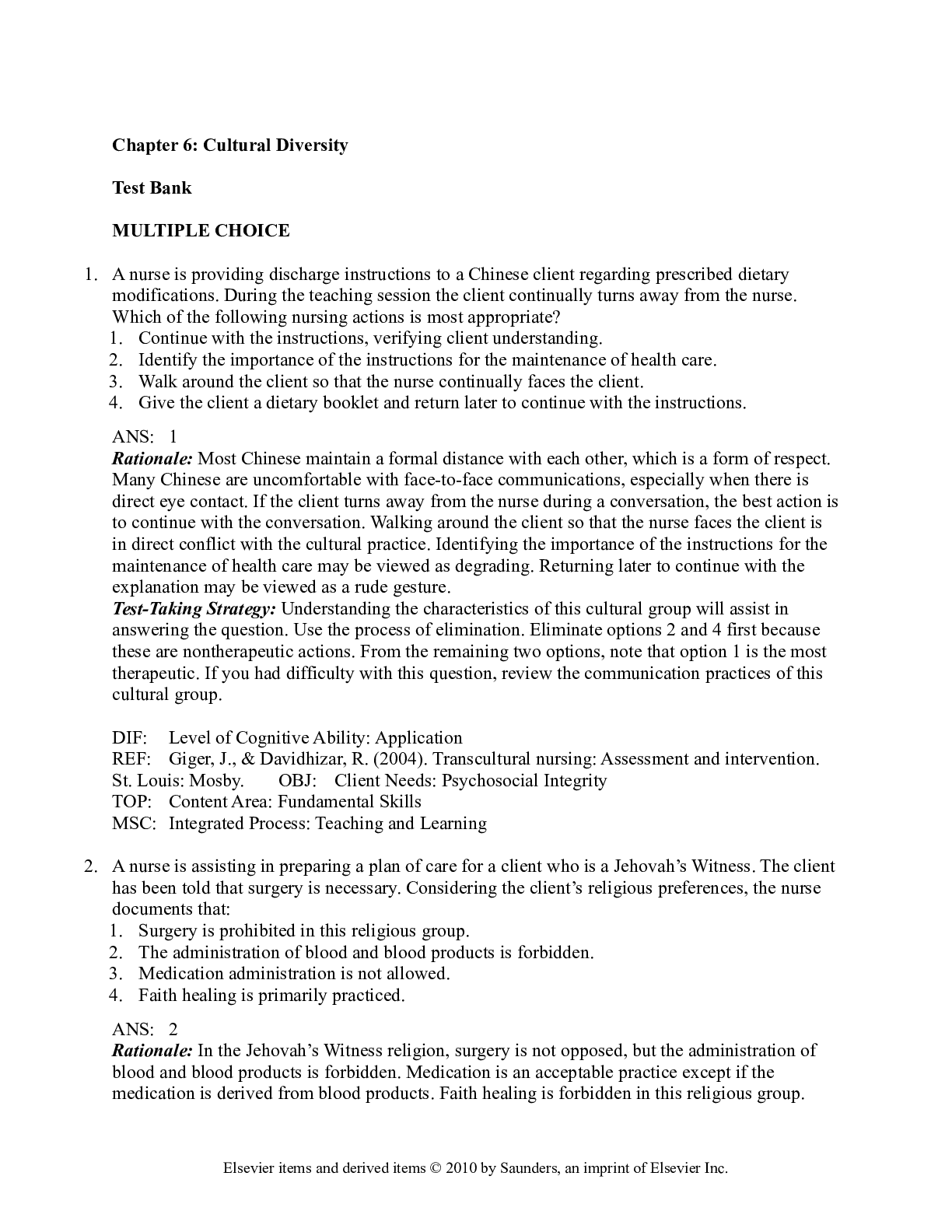
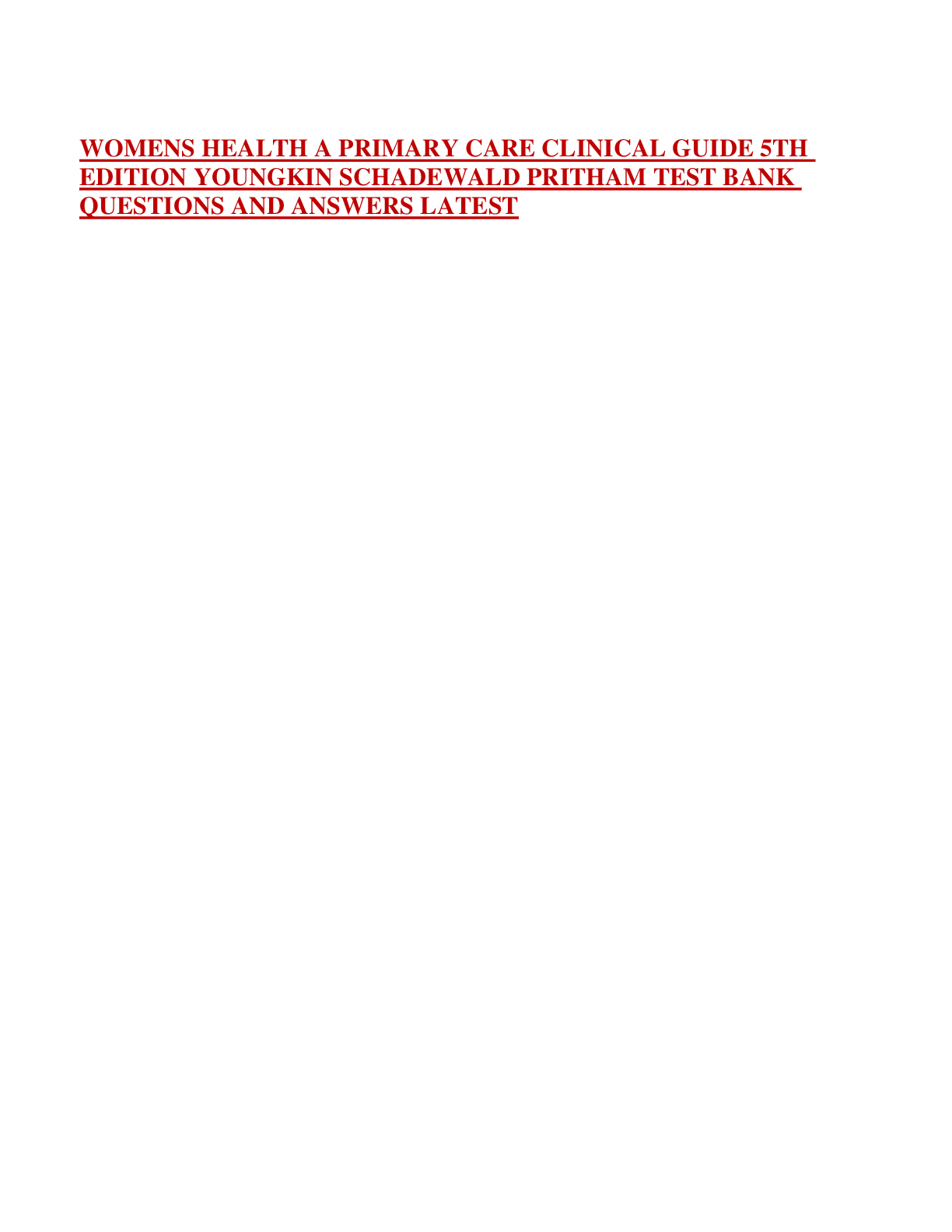

.png)
